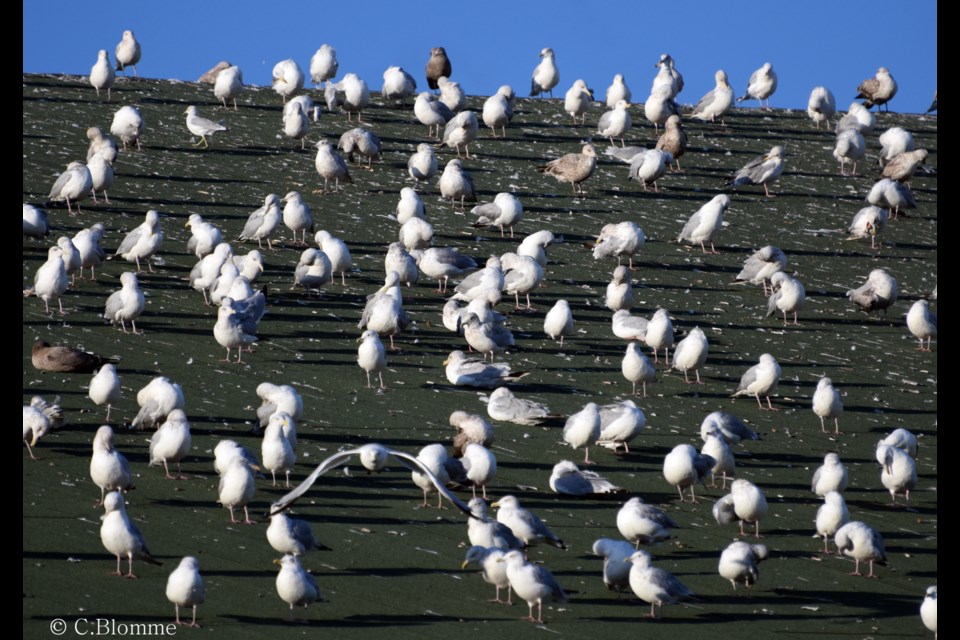The snow storm in the late afternoon of Dec. 7 resulted in many fender benders and ditched vehicles.
The Jeep that over rode the shoulder near the Hannah Lake’s back road was particularly off the vertical plain. Inclement weather is a good time for “us humans” to stay home, stay off the roads and perhaps relax in the cozier indoor environment.
The wildlife, however, needs to do other things to stay protected. This time of the year is a little iffier for the winter gulls and late diving ducks. They seem to want to tempt fate.
Some of the shallower lakes might freeze overnight only to be released of the ice barrier when the wind blows or the temperatures increase a bit. It means that there can be open water in many places and thus access to swim areas and food, particularly if you need to dive for your supper.
This transition period often means some of the migrants hang on for a period of time.
As a resident of Greater Sudbury and area, you may have noticed huge numbers of largish birds in the sky in the early morning and late evening.
You may have noticed a large group of these birds perched on the low angle roof of the arena on your way in to watch the Wolves (preferably win). They gather on these low areas in the afternoon and just before the sun sets they lift off into the sky and make their way to a nearby lake.
Ramsey Lake is one of the frequented areas because the water stays open longer there than on most lakes. Other areas that are used include Robinson, Kelly and Minnow lakes, to name a few.
As the weather gets colder, the birds will congregate on ice patches and spend the dark hours of the night in large protective groups huddled together for warmth. The huge flocks of gulls we get this time of year are by no means our resident birds.
Birds that may have reproduced along the North Channel colonies and further north make a casual migration south to the shores of the Great Lakes and eastern sea board. The birds we have now may come from very distant lands indeed.
It is at this time of year local birders will seek out our Arctic visitors as well. In small numbers observers may get lucky enough to see Iceland gulls, glaucous gulls, great black-backed gulls and maybe even the elusive Thayer’s gull.
To give you some perspective, in a flock of 300 herring gulls riding on Ramsey Lake in early December you might only see 10 birds of the more uncommon species I have just mentioned. It might explain why the lady with her restrained white dog at Bell Park was wondering what I was doing staring out into space.
Then there is the problem of identification. Herring gulls may take up to three years to reach adulthood. They have feather moults that change their plumage configuration and colours over these three years and there are personal differences within the group in terms of intensity of colour.
All browns and greys are not created equal! It means that there is a bit of sorting out to do when you want to identify the unusual birds. The Iceland and glaucous gulls are two species sometimes referred to as the white-winged gulls.
This is a real bonus. It means that when you scan the hundreds of birds on the water you can look for the very light coloured, almost white first-year birds in this group. White wing tips will certainly have narrowed down the field to identify your mystery gull.
Getting back to snow storms. Though many of us may venture for the indoors sometimes, it is worth a quick cold trip to a lake to see what the gulls are doing. They congregate in numbers and find areas that are safer from extreme winds.
That concentration allows a look for the white-winged gulls that may have come to visit our area briefly on their route further south. They are quite attractive if you give them a chance. And sometimes there is a surprise. A lone common loon was sitting on the water at the time of my visit.
Someone should tell it which way is south!
Chris Blomme is an executive member of the Sudbury Ornithological Society and works with animals at Laurentian University. Have a question for Chris? Send it to [email protected].
